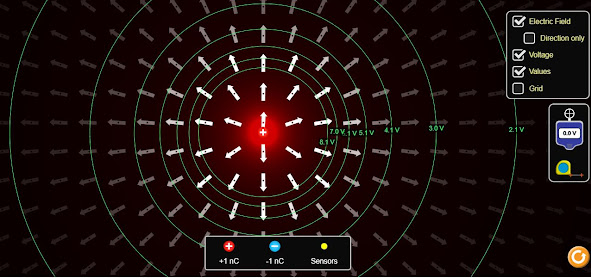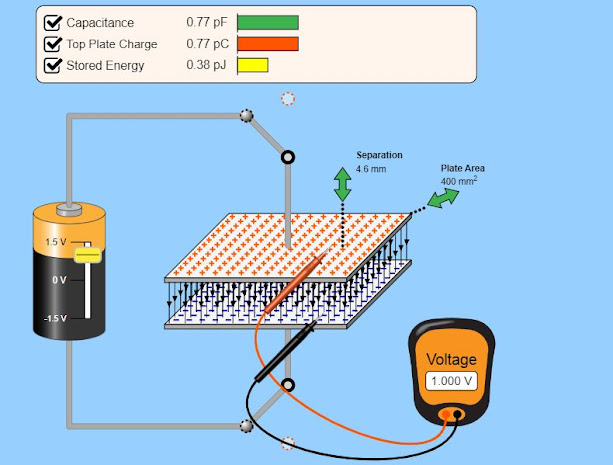NCERT Example 8.2
Coulomb’s law for electrostatic force between two point charges and Newton’s law for gravitational force between two stationary point masses, both have inverse-square dependence on the distance between the charges and masses respectively. (a) Compare the strength of these forces by determining the ratio of their magnitudes (i) for an electron and a proton and (ii) for two protons. (b) Estimate the accelerations of electron and proton due to the electrical force of their mutual attraction when they are 1 Å (= $10^{-10}$ m) apart? ($m_p$ = 1.67 × $10^{–27}$ kg, $m_e$ = 9.11 × $10^{–31}$ kg)
If $10^9$ electrons move out of a body to another body every second, how much time is required to get a total charge of 1 C on the other body?
How much positive and negative charge is there in a cup of water?
NCERT Example 1.2 How much positive and negative charge is there in a cup of water?
Home



Quick Links in this Website:
11P03 Motion in a Plane 2D
Circular Motion
To simulate car accidents, auto manufacturers study the collisions of moving cars with mounted springs of different spring constants. Consider a typical simulation with a car of mass 1000 kg moving with a speed 18.0 km/h on a smooth road and colliding with a horizontally mounted spring of spring constant 5.25 × 10^3 N m–1. What is the maximum compression of the spring ? Example 5.9 Consider Example 5.8 taking the coefficient of friction, µ, to be 0.5 and calculate the maximum compression of the spring.
Example 5.8 To simulate car accidents, auto manufacturers study the collisions of moving cars with mounted springs of different spring constants. Consider a typical simulation with a car of mass 1000 kg moving with a speed 18.0 km/h on a smooth road and colliding with a horizontally mounted spring of spring constant $5.25\times 10^3 Nm^{-1}$ . What is the maximum compression of the spring ? [NCERT Class 11 Example 5.8]
Example 5.9 Consider Example 5.8 taking
the coefficient of friction, µ, to be 0.5 and
calculate the maximum compression of the
spring. [NCERT Class 11 Example 5.9]
$5.25\times 10^3 Nm^{-1}$ corrected as $6.25\times 10^3 Nm^{-1}$
Three concentric spherical shells have radii a, b and c (a < b < c) and have surface charge densities σ,−σ and σ respectively. If VA, VB and VC denotes the potentials of the three shells, then for c = a + b, we have [NEET 2009]
A man of 50 kg mass is standing in a gravity free space at a height of 10 m above the floor. He throws a stone of 0.5 kg mass downwards with a speed of 2 m/s. When the stone reaches the floor the distance of the man above the floor will be
Concepts: Conservation of Linear momentum. Similar to the recoiling of gun. When the man pushes the stone downward the man will get pushed upward. Since there is no external force acting on the system, conservation of linear momentum is valid and center of mass of the whole system remains in the same location.
12P01 Electric Charges and Fields
Step-by-step
How to solve Numerical problem in physics?
How
to solve Numerical problem in physics?
“Start walking. The path will become clearer”
·
Nature
is written in the language of Mathematics. Drawing is the language of Engineers
and Scientists.
·
Read
the question line by line converting it into a simple cartoon diagram or a
mathematical expression. Mark the numerical values in appropriate places in the
diagram or with the mathematical notations.
Charged Particle in a Uniform Electric Field. Calculate the vertical distance from the center line from where the particle will exit the parallel plate region.
One face of a rectangular glass plate 6 cm thick is silvered. An object held 8 cm in front of the first face forms an image 12 cm behind the silvered face. The refractive index of the glass is
One face of a rectangular glass plate 6 cm thick is silvered. An object held 8 cm in front of the first face forms an image 12 cm behind the silvered face. The refractive index of the glass is
A) 0.4 B) 0.8 C) 1.2 D) 1.6
12P02 Electric Potential and Capacitance
12P07 Alternating Current
In a double slit experiment two coherent beams have slightly different intensities I and $\delta I$. Show that the resultant intensity at the maxima is nearly 4I, while that at the minima is $(\delta I)^2/4I$
FAQs by parents for Physics Class
"Teacher does not teach.Student learns.Teacher just helps in the process of learning."
Frequently asked questions for Physics Class
Pure Si at 500 K has equal no. of electron (n_e) and hole (n_h) concentrations of 1.5 ×10^16 m^-3. Doping by Indium increases n_h to 4.5 ×10^22 m^-3. Find the no. of electrons in the doped semiconductor and identify if it is p-type or n-type.
NEET PYQ, 12P14 Semiconductor Materials and Devices, p-type n-type semiconductor
12P14 Semiconductor Study Notes
Quantity of water or liquid flowing out of a tank through a hole orifice at the bottom of the tank. Mathematical Modelling and Experimental Results.
Quantity of water or liquid flowing out of a tank through a hole orifice at the bottom of the tank. Mathematical Modelling and Experimental Results.
Application of Integration methods to model quantities that are changing continuously in a non-linear fashion with respect to time.
This work was started as a way to illustrate the power of calculus in mathematical modelling to class 11 and 12 students, when we deal with quantities that are not changing linearly with respect to time or other variable. However the integration methods look slightly complicated and may be suitable only for college level students and fluid mechanics students.
Mathematical Model PDF File
Excel Calculations and Graphs Excel File












